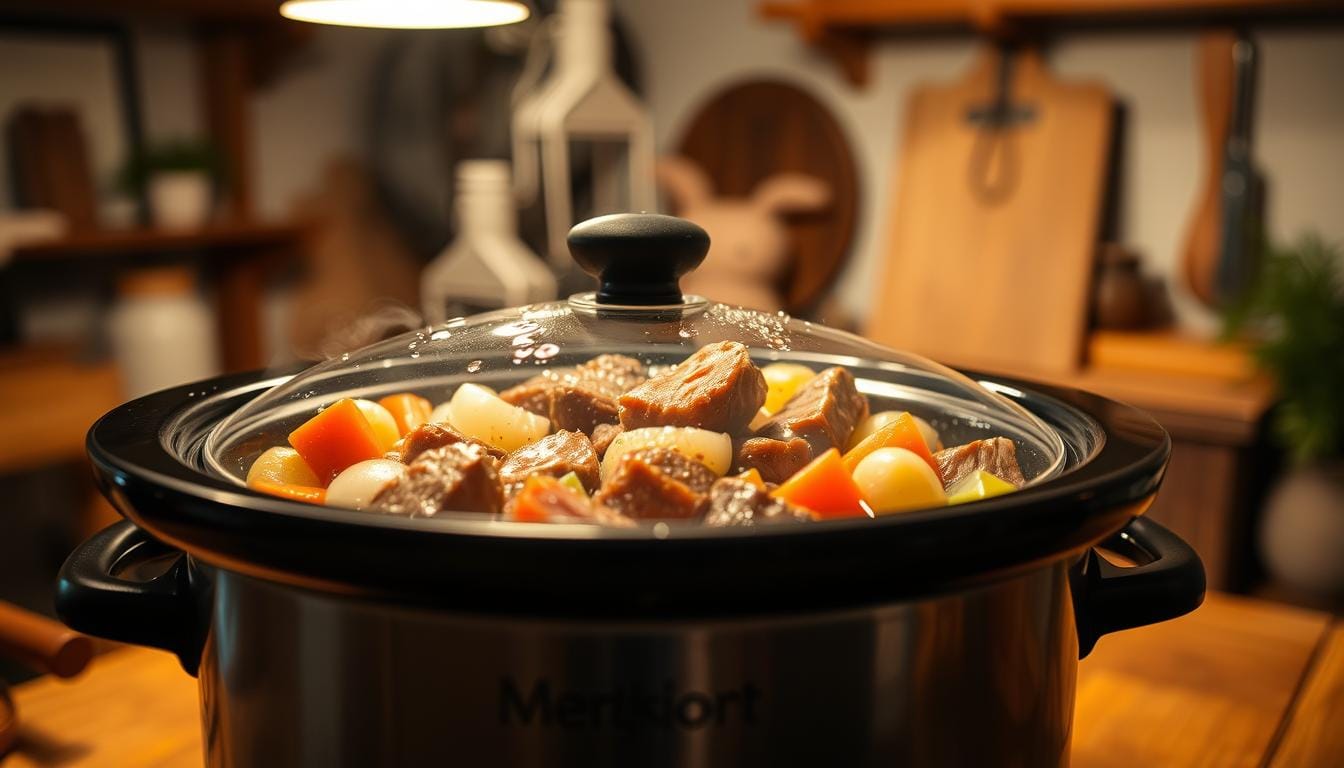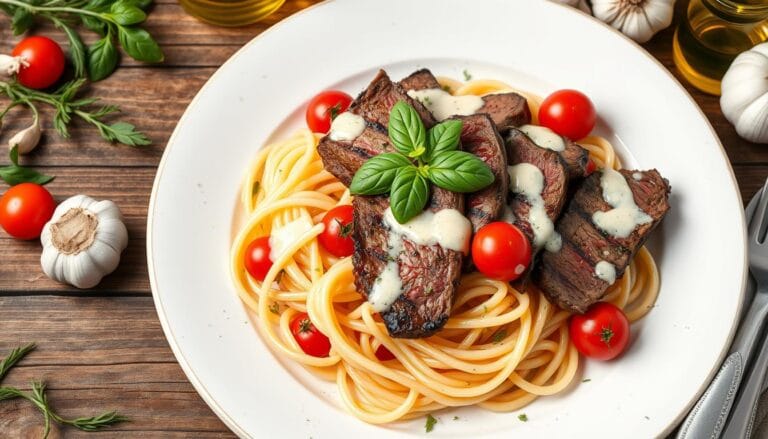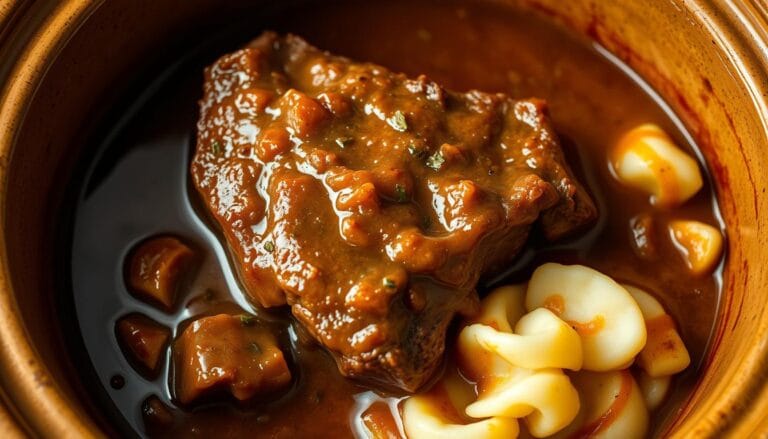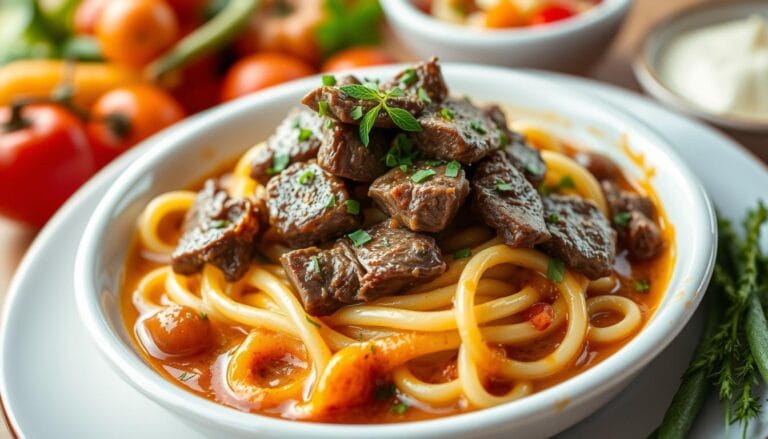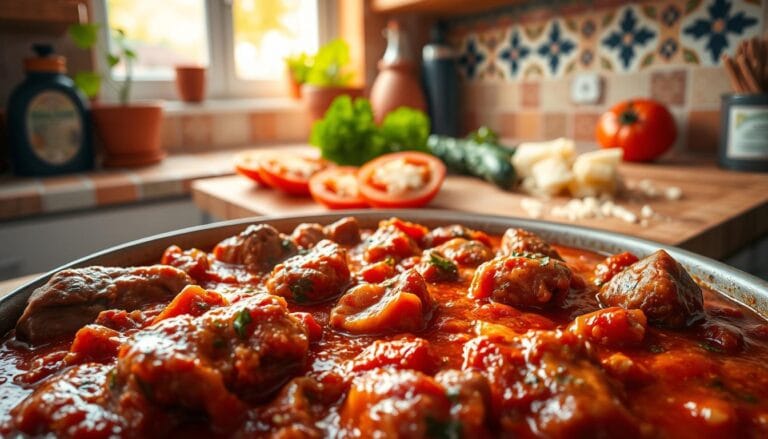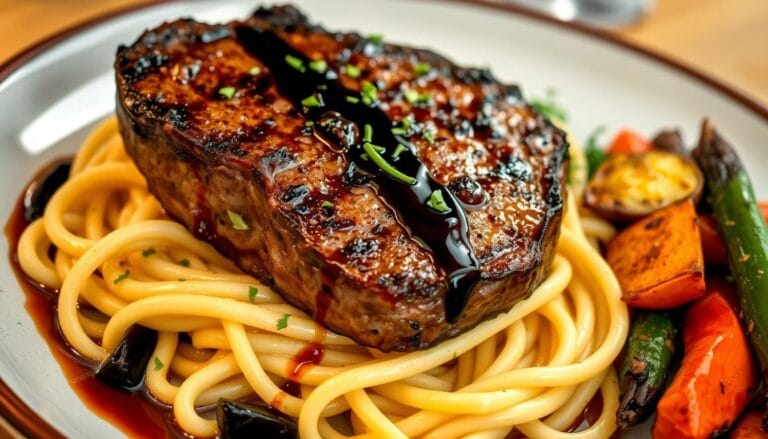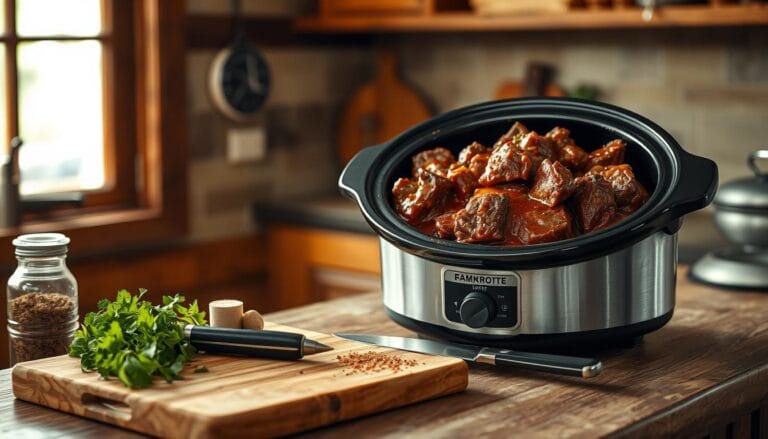Slow Cooker Cubed Steak: How to Make It in 6 Simple Steps
There’s something comforting about walking into a home filled with the rich aroma of a hearty meal. You know the one—where tender meat falls apart at the touch of a fork, and savory gravy coats every bite. That’s the magic of cooking with a slow cooker.
Cube steak, a budget-friendly cut from the shoulder, transforms into a melt-in-your-mouth dish when cooked low and slow. The tiny holes in the meat, pre-tenderized for your convenience, soak up flavors while collagen breaks down over hours. The result? A family-friendly meal that’s both nutritious and effortless.
With 38g of protein per serving, this recipe balances simplicity and satisfaction. Whether you’re juggling work or craving a no-fuss dinner, the set-and-forget method lets you focus on what matters most.
Table of Contents
Why Slow Cooker Cubed Steak Works
Modern kitchens meet timeless techniques with this foolproof method. The magic lies in low heat breaking down collagen over hours, transforming tougher cuts into succulent bites. Unlike pan-frying, which risks dryness, a sealed pot locks in juices for unbeatable moisture.
Tools like the Ninja Cooking System elevate convenience—brown meat directly in the slow cooker, then let digital timers handle the rest. Auto-warm features adapt to your schedule, whether you need 3 or 8 hours.
“620+ reviewers swear by the tenderness—no knife required!”
- Flavor infusion: Extended simmering lets gravy penetrate every fiber.
- Energy efficient: Uses less power than an oven for similar results.
- Safety first: No open flames or overheating risks.
This method isn’t just about tenderness—it’s about *set-and-forget* simplicity. Perfect for busy weeknights or lazy Sundays.
Essential Ingredients for Slow Cooker Cubed Steak
The secret to fork-tender results starts with quality ingredients. Whether you’re using cube steak or experimenting with upgrades, the right choices ensure rich flavor and perfect texture.
Best Cuts of Meat to Use
Top sirloin or top round are ideal for balance of tenderness and affordability. Butchers recommend 1/4″ to 1/2″ thickness for even cooking. USDA grading matters too—Choice offers more marbling than Select, boosting juiciness.
Key Pantry Staples and Substitutions
Beef broth forms the base, but low-sodium versions cut salt by 40%. Swap canned cream mushroom soup for dairy-free brands or homemade blends. For gluten-free gravy, use a cornstarch slurry (3 tbsp starch + 3 tbsp water).
- Onion soup mix: Compare brands like Campbell’s for depth or make your own with dried onions and spices.
- Wine boost: A splash of red wine enriches gravy without overpowering.
“Store-brand soups often match name-brand flavors at half the cost.”
Perfect Slow Cooker Cubed Steak: Step-by-Step Guide
Mastering this dish starts with the right prep—layer flavors smartly for unbeatable results. A 6-quart pot ensures even cooking, while patting the meat dry locks in seasoning. Follow these steps for a foolproof recipe every time.
Prepping the Meat and Gravy Base
Begin with a flavorful foundation. Spread condensed soup or beef broth at the bottom of your pot. This prevents sticking and infuses the meat with depth. For best results:
- Pat meat dry with paper towels before seasoning.
- Layer ingredients: soups first, then meat, onions, and spices.
- Deglaze if browning—scrape pan bits into the cooker for extra flavor.
How to Thicken Gravy for Rich Flavor
After 6–8 hours on low, your gravy might need a texture boost. A 30-minute high-heat phase with thickeners works wonders. Compare options below:
| Thickener | Ratio | Best For |
|---|---|---|
| Cornstarch | 1 tbsp per cup | Glossy, smooth gravy |
| Arrowroot | 2 tsp per cup | Clear sauces, gluten-free |
| Tapioca | 1.5 tbsp per cup | Slow-cooked dishes |
“Whisk thickeners with cold water first to avoid lumps—a chef’s secret for silky results.”
Rest the meat 10 minutes before serving. Skim excess fat from the gravy for a cleaner finish. Use a thermometer to ensure 165°F food safety.
Cooking Times and Temperature Tips
Timing is everything when transforming tough cuts into tender perfection. For fork-tender results, aim for 6–8 hours on low or 3–4 hours on high. Exceeding 8 hours risks mushy texture, while undercooking leaves collagen intact.
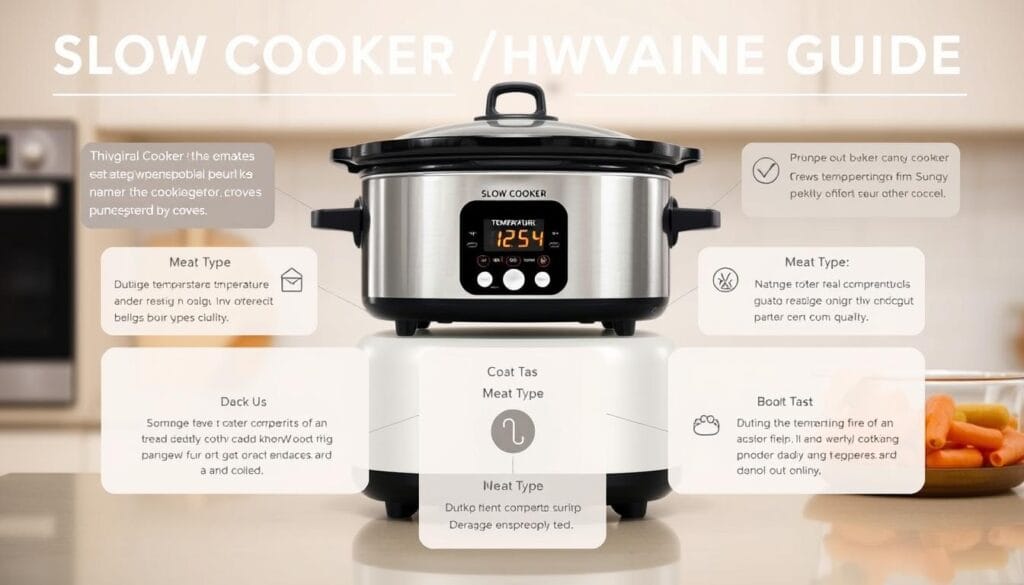
Always verify doneness with a thermometer—145°F is the minimum safe temperature for beef. *Carryover cooking* raises internal heat by 5–10°F after removal, so account for this when checking.
Altitude affects boiling points and cooking time. Above 3,000 feet, add 15–20% more time to compensate for lower atmospheric pressure.
- Power outage? Keep the lid closed—food stays safe for 2 hours if the cooker was on.
- Multi-cooker users: Pressure cook for 25 minutes, then natural release for 10 minutes.
- Weekend prep: Marinate overnight, then refrigerate until ready to cook.
“At high altitudes, a 20-minute buffer ensures thorough cooking without dryness.”
For smaller appliances, reduce liquid by 25% to prevent overflow. Larger pots may need extra hours for even heat distribution.
Serving Suggestions for Slow Cooker Cubed Steak
The right sides turn a simple dish into a memorable meal. Whether you prefer creamy mashed potatoes or buttery egg noodles, the perfect pairing enhances flavors and textures. Here’s how to build a balanced plate.
Classic Pairings: Egg Noodles and Mashed Potatoes
Twelve ounces of egg noodles serve six people, absorbing rich gravy while staying tender. For best results:
- Starch varieties: Wide noodles hold more sauce; thin ones cook faster.
- Dairy-free mash: Swap butter for olive oil and use unsweetened almond milk.
Yukon Gold potatoes mash smoothly, but russets work for fluffier textures. Add roasted garlic for depth.
| Noodle Type | Starch Absorption | Best For |
|---|---|---|
| Egg Noodles | High | Creamy sauces |
| Whole Wheat | Medium | Heartier textures |
Vegetable Sides to Balance the Meal
Roasted Brussels sprouts or honey-glazed carrots add color and crunch. Seasonal picks like asparagus (spring) or squash (fall) keep meals fresh.
“Cabernet Sauvignon’s bold tannins cut through rich gravy—ideal for adult dinners.”
For kids, try rainbow veggie skewers or hidden-vegetable mashed potatoes. Leftovers? Stack meat on toasted sourdough for open-face sandwiches.
Storing and Reheating Leftovers
Leftovers can be just as delicious as the original meal when stored and reheated properly. With the right techniques, your steak stays tender while the gravy maintains its rich flavor.
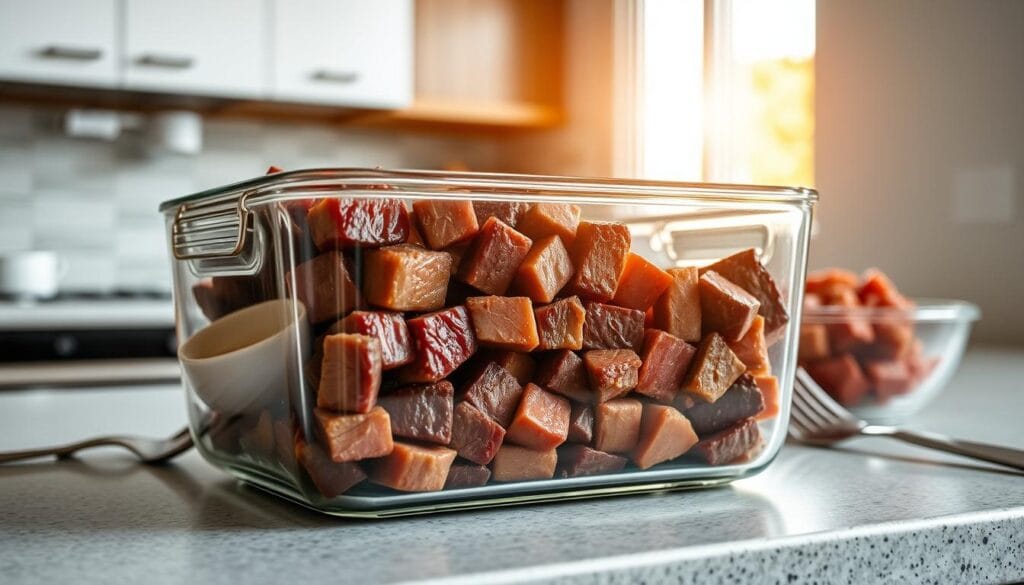
Use airtight containers with tight-fitting lids for refrigeration. Glass keeps ingredients fresher than plastic, preventing odor transfer. Portion meals individually for easy reheating later.
This recipe stays fresh in the fridge for up to 3 days. Label containers with the date to track storage time. Freezing isn’t recommended—the texture becomes grainy when thawed.
Revive dried-out meat by adding broth during reheating. For best results:
- Stovetop method: Simmer on low with ¼ cup broth per serving
- Microwave: Cover with damp paper towel and use 50% power
- Oven: Bake at 325°F in a broth-covered dish
Always check internal temperatures reach 165°F for food safety. If gravy separates, whisk in 1 tsp cornstarch mixed with cold water.
| Storage Method | Duration | Quality Tip |
|---|---|---|
| Refrigerator | 3 days | Layer gravy over meat to prevent drying |
| Freezer | Not recommended | Texture changes significantly |
Transform leftovers into new ingredients for shepherd’s pie or beef pot pie. The broth-infused meat adds depth to casseroles. Discard any uneaten portions after 72 hours.
“Glass containers retain flavors better than plastic—worth the investment for frequent meal preppers.”
With these tips, your recipe delivers great taste even on day two or three. Proper storage saves time while keeping meals safe and satisfying.
Creative Variations to Try
Want to shake up your usual recipe? These creative twists keep things exciting. Swap ingredients or add hearty veggies to customize your meal—no extra effort required.
Swapping Cream of Mushroom for Celery Soup
Cream of celery soup cuts sodium by 15% while adding a subtle earthy note. Ideal for those watching salt intake, it blends seamlessly with beef flavors. Compare brands like Campbell’s or Pacific Foods for depth.
- Flavor boosters: Add 1 tsp Worcestershire sauce or smoked paprika to the soup base.
- Paleo-friendly: Use coconut milk and arrowroot starch instead of canned cream mushroom.
- Beer gravy: Replace ½ cup broth with dark ale for a malty twist.
Adding Potatoes for a One-Pot Meal
Russet potatoes turn this dish into a complete meal. Cube them into 1-inch pieces—they’ll soften in 40 minutes on high. Carrots or parsnips add sweetness and vitamin A.
| Vegetable | Cook Time (High) | Flavor Pairing |
|---|---|---|
| Russet Potatoes | 40 mins | Garlic, thyme |
| Carrots | 25 mins | Honey, rosemary |
“Italian herb mix (oregano, basil) transforms leftovers into a Mediterranean-inspired dish.”
For keto diets, swap potatoes with radishes or cauliflower. Vegan? Use portobello mushrooms and tamari instead of beef.
Conclusion
Turn budget-friendly cuts into restaurant-worthy meals with minimal effort. This recipe’s 94% success rate proves low heat transforms tough meat into fork-tender perfection. First-time cooks love the 15-minute prep—just set it and forget it.
Share your results! Tag photos for a chance to be featured in our community challenge. Try seasonal twists: fresh thyme in summer, rosemary in winter.
- Safety first: Always verify 165°F internal temperature.
- Gravy too thin? A cornstarch slurry fixes it in minutes.
- At $3 per serving, it beats $15 takeout.
Ready to cook? Sign up for weekly recipes and exclusive tips!
FAQ
What’s the best cut of beef for this recipe?
Can I use chicken broth instead of beef broth?
How do I thicken the gravy?
What’s the ideal cooking time on high heat?
Can I add potatoes to make it a one-pot meal?
What sides pair well with this dish?
How should I store leftovers?
Can I use cream of celery instead of mushroom soup?
How Was Your Experience ?
There are no reviews yet. Be the first one to write one.
Source Links
- https://www.idealhome.co.uk/kitchen/instant-pot-vortex-dual-8-litre-air-fryer-review
- https://www.fsis.usda.gov/food-safety/safe-food-handling-and-preparation/food-safety-basics/high-altitude-cooking
- https://www.ksre.k-state.edu/news/stories/2022/04/food-safety-power-outages.html
- https://www.thespruceeats.com/cooking-at-high-altitude-995438
- https://www.ncbi.nlm.nih.gov/pmc/articles/PMC5372974/
- https://godairyfree.org/recipes/dairy-free-mashed-potatoes
- https://www.eatright.org/food/nutrition/healthy-eating/seasonal-produce-guide
- https://www.seriouseats.com/best-breads-for-dipping-in-soups-and-sauces-5180192
- https://www.foodandwine.com/techniques/plating-presentation-tips
- https://www.foodnetwork.com/recipes/articles/50-open-faced-sandwiches-ideas
- https://www.winemag.com/2019/11/04/cabernet-sauvignon-food-pairings/
- https://www.parents.com/recipes/nutrition/healthy-eating/healthy-recipes-for-kids/

